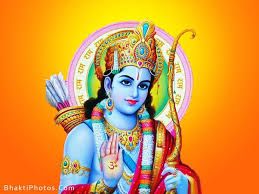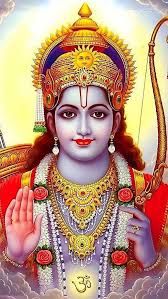Jai Shri Ram: Exploring the Significance and Cultural Context of a Sacred Chant
Introduction:
“Jai Shri Ram” is a powerful and widely recognized Hindu mantra that holds deep cultural and religious significance in India. Translated to English, it means “Hail Lord Rama,” with Rama being one of the most revered deities in Hinduism. The chant has transcended its religious context and has become a symbol of cultural identity and unity. In this article, we will explore the historical and cultural background of “Jai Shri Ram” and its multifaceted role in shaping the socio-religious fabric of India.

Historical Context:
The origin of the chant “Jai Shri Ram” can be traced back to the ancient Indian epic, the Ramayana. The Ramayana, attributed to the sage Valmiki, narrates the life and adventures of Lord Rama, an incarnation of the god Vishnu. Rama is celebrated for his unwavering devotion to dharma (righteousness) and his exemplary conduct as a ruler, husband, and son.
The phrase “Jai Shri Ram” gains prominence in the Ramayana as a rallying cry of Rama’s devotees during significant events, including the rescue of his wife, Sita, from the demon king Ravana. Over time, this chant evolved into a powerful mantra, symbolizing the victory of good over evil and invoking the divine blessings of Lord Rama.
Religious Significance:
In Hinduism, the chanting of sacred mantras is considered a potent means of connecting with the divine. “Jai Shri Ram” is not just a set of words; it is a devotional expression that encapsulates the devotee’s reverence and surrender to Lord Rama. The mantra is recited during prayers, rituals, and religious ceremonies, creating an atmosphere of spiritual sanctity.
Devotees believe that chanting “Jai Shri Ram” can purify the mind, bring inner peace, and invite the divine presence into their lives. The repetition of the mantra is seen as a way to seek protection, blessings, and guidance from Lord Rama, who is regarded as the embodiment of virtue and righteousness.
Cultural Symbolism:
Beyond its religious connotations, “Jai Shri Ram” has taken on a broader cultural significance in India. The chant has become a symbol of cultural identity, particularly associated with the Hindu community. In recent times, it has been used as a slogan during socio-political movements, serving as a unifying force for those who identify with the cultural ethos it represents.
However, it’s essential to note that the cultural and political usage of “Jai Shri Ram” has been a subject of debate and controversy. While some view it as an expression of cultural pride and solidarity, others argue that its deployment in certain contexts may contribute to tensions and divisions within the diverse Indian society.
Contemporary Debates:
In contemporary India, “Jai Shri Ram” has become entwined with political discourse and has been invoked in various social and political movements. The slogan has been used as a form of protest, celebration, and assertion of cultural identity, sometimes leading to heated debates and discussions on secularism and religious harmony.
Critics argue that the politicization of the chant can undermine its spiritual and cultural essence, reducing it to a tool for mobilization rather than a sacred invocation. Others maintain that the cultural and religious diversity of India should be respected, and the chant should not be wielded in ways that promote exclusion or intolerance.
Societal Impact:
The widespread usage of “Jai Shri Ram” in various social and political contexts has led to both positive and negative societal impacts. On the positive side, the chant has been a source of inspiration and motivation for individuals during times of social change. It has been employed as a symbol of resistance against perceived injustices, as well as a call for the preservation of cultural values and traditions.
Conversely, its usage in certain situations has been criticized for contributing to religious polarization. Instances of the slogan being used to intimidate or marginalize religious minorities have sparked concerns about its potential misuse. This has fueled debates about the delicate balance between freedom of expression and the need to maintain a harmonious and inclusive society.
Cinematic and Artistic Influence:
“Jai Shri Ram” has also found its way into various forms of artistic expression, including literature, music, and cinema. The Ramayana, the epic from which the chant originates, has been a perennial source of inspiration for writers and poets across centuries. Musicians have incorporated the chant into devotional songs, creating a cultural resonance that extends beyond religious boundaries.
In cinema, the stories from the Ramayana, and by extension the chant “Jai Shri Ram,” have been portrayed in numerous films, plays, and television series. These adaptations contribute to the cultural narrative and have played a role in keeping the traditions and stories associated with the chant alive for contemporary audiences.
Interfaith Dialogues:
While “Jai Shri Ram” is rooted in Hindu tradition, it has also become a point of discussion and dialogue between different faiths. Interfaith gatherings often explore the commonalities and shared values among diverse religious communities. The chant, with its emphasis on virtue, righteousness, and the triumph of good over evil, serves as a point of connection for individuals from various religious backgrounds seeking common ground.
Interfaith dialogues provide an opportunity to deepen mutual understanding and respect, fostering an environment where individuals can appreciate the cultural and spiritual significance of “Jai Shri Ram” within the broader context of India’s religious landscape.
Global Recognition:
In the age of globalization, “Jai Shri Ram” has gained recognition beyond the borders of India. Indian diaspora communities around the world continue to use the chant as a means of preserving their cultural identity and connecting with their roots. Additionally, the popularization of yoga, meditation, and other facets of Indian spirituality has contributed to the global familiarity of Hindu mantras, including “Jai Shri Ram.”
Origin and Historical Evolution of “Jai Shri Ram” Chant
The origin of “Jai Shri Ram” can be traced back to ancient India, primarily to the revered Hindu epic, the Ramayana. The Ramayana, traditionally attributed to the sage Valmiki, is a narrative poem that unfolds the life and adventures of Lord Rama, the seventh avatar of the god Vishnu. The story, set in the Treta Yuga, is a foundational text in Hindu literature and philosophy.
In the Ramayana, “Jai Shri Ram” emerges as a celebratory chant during pivotal moments in Lord Rama’s journey. Notably, it gains prominence during the rescue of Rama’s wife, Sita, from the demon king Ravana. As Rama and his allies, including the monkey-god Hanuman, succeed in defeating Ravana and rescuing Sita, the chant becomes an expression of victory and devotion. The words “Jai Shri Ram” reverberate through the epic as a rallying cry, symbolizing the triumph of righteousness over evil.
The Ramayana, composed over two millennia ago, has played a crucial role in shaping the cultural and spiritual landscape of India. “Jai Shri Ram” transcended its literary origins, becoming an enduring mantra and devotional expression among Hindus.

Religious Significance and Ritual Practices:
The phrase “Jai Shri Ram” holds profound religious significance in Hinduism. Devotees believe that the repetition of these words, often through chanting or prayer, establishes a direct connection with the divine. The mantra is considered a powerful invocation that seeks the blessings and protection of Lord Rama.
In religious rituals and ceremonies, especially those dedicated to Rama, “Jai Shri Ram” is recited to create an atmosphere of spiritual sanctity. The chant is believed to purify the mind, evoke divine grace, and cultivate a sense of devotion among the worshippers.
Cultural Adaptations and Regional Variances:
Over the centuries, “Jai Shri Ram” has adapted to various regional and cultural contexts within India. Different linguistic and cultural communities have embraced the chant, incorporating it into their religious practices and festivities.
The cultural adaptations of the chant extend to diverse art forms such as music, dance, and drama. Folk traditions, in particular, have kept the spirit of “Jai Shri Ram” alive through oral traditions, storytelling, and vibrant performances that celebrate the epic tales of the Ramayana.
Political Appropriation and Social Movements:
In recent times, “Jai Shri Ram” has transcended its religious and cultural dimensions to become a symbol with political connotations. The slogan has been invoked during socio-political movements and protests, often as a rallying cry for a particular cause. Its usage has stirred debates about the intersection of religion and politics, with critics expressing concerns about the potential for the chant to be weaponized for divisive purposes.
The appropriation of “Jai Shri Ram” in political discourse has led to varied interpretations and reactions. Some view it as a unifying force, aligning with cultural and national identity, while others raise concerns about its potential to exacerbate religious tensions.
“Jai Shri Ram” has a rich and multifaceted history that spans thousands of years, from its roots in the ancient scriptures to its contemporary significance in the complex socio-cultural and political landscape of India. As the chant continues to resonate in the hearts and minds of millions, its journey reflects the enduring power of cultural symbols to evolve, adapt, and shape the collective consciousness of a diverse and dynamic society.
Conclusion:
“Jai Shri Ram” encapsulates a rich tapestry of religious, cultural, and historical elements within the context of India. Its roots in the ancient epic of the Ramayana, its religious significance as a mantra, and its contemporary role as a cultural symbol highlight the complexity and depth of this sacred chant. As India continues to navigate its diverse socio-religious landscape, the chant serves as a reminder of the shared cultural heritage that transcends individual beliefs and affiliations. Ultimately, “Jai Shri Ram” remains a powerful expression that resonates with millions, carrying with it a profound connection to the spiritual and cultural heritage of the Indian subcontinent.
